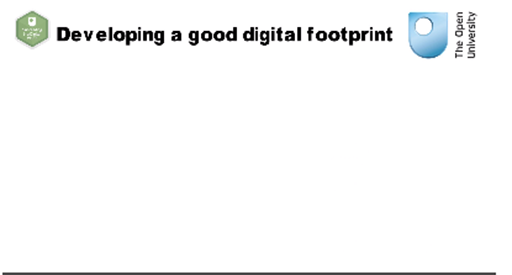1 What is my current online brand?
When considering how you want to represent your brand online, a useful place to start is by assessing what is currently out there. For example, you may have images on your Facebook page that are less than professional! Would you want a potential employer or professional contact to see them?
Note: If you feel a little uncertain at this point and want to take a step back and develop your skills and confidence about life online, the OpenLearn course Digital literacy: succeeding in a digital world [Tip: hold Ctrl and click a link to open it in a new tab. (Hide tip)] is a great starting point.
Activity 1 Google it!
A good starting point is to Google yourself and see what comes up. That is what an employer or networking contact will often do.
Do that now. Enter your name into the search box and see what comes up. Make sure you also check ‘Images’ as that is where photos might appear.
In the box below, make a note of anything that surprises you or that you want to delete or make private.
Discussion
Did you find anything that surprised you? Sometimes we can be tagged in other people’s photos unexpectedly. If unwanted content did come up, it might be good idea to try other search engines too, e.g. Bing.
It is important to realise that when you post something on a social media platform, what you are actually doing is publishing it, and it can’t always be retracted. Grothaus (2018) offers the following tips for tidying up your digital footprint:
- Make your social media accounts private
- Review your timelines – remove any photos or comments that could cast you in a negative light
- Control tagging – tags with your name can often come up in Google searches. You can either untag yourself, ask friends to untag you or investigate how the platform allows you to disable other people from tagging you in the first place
- Find and close any old social media accounts – if you’ve forgotten what they are, Google your name to see what comes up or try a service like Deseat.me which aims to help you find all your forgotten online accounts.
If you can’t delete everything, Majeed (2016) suggests frequently posting more positive material to drive out any negative results. She also suggests Google Alerts (https://www.google.co.uk/alerts) as a handy tool for telling you whenever you are mentioned online.
If you want to find out more about this topic, the OpenLearn course Digital Literacy: Succeeding in a Digital World has some useful content, including the following video about how to improve your digital footprint:

Transcript: Video 2 Ten top tips to improve your digital footprint
Once you understand how important your digital footprint is, you can start to think about how you might improve the way in which you come across online. So let's see how you can do this. One of the first things you can do is to delete or deactivate all those online accounts that you don't use anymore. Doing this will mean that you won't need to worry about them, they can't be scammed, and it will leave you time to concentrate on the accounts that are most useful to you. There are tools available online that can help you do this.
For the accounts you choose to keep, think about who has access to them and filter out people you don't really know or no longer keep in contact with. For example, Facebook tends to be more personal, so you may only want family and friends to have access to the information you put there. However, if you use LinkedIn, you will want to connect with a professional network and be considered for jobs. If you want to be noticed, your settings should allow greater public access.
However, the information you provide is likely to be professional rather than personal. Now is the time to delete all those photographs that don't show you in a good light. Also, delete any posts that you're not proud of. Social network sites will provide you with information on how to do this. Sites like LinkedIn are great for showcasing your skills and knowledge.
If you want to get noticed, you'll need to ensure that you build up your profile to include your achievements, skills, qualifications, and knowledge. Consider your profile as your online CV. Employers or employment agencies frequently search LinkedIn for people with specific skills. When you think about the words you use on your profile, think about the words for which employers might search in order to find people with your skills.
There are a number of ways you can connect with others in your profession or field of interest. Twitter is a good place to find connections. Being active on Twitter will make it more likely that people will notice you. Stick to professional content and think about what your tweets are saying about you in a professional sense.
Blogs are also a great way of showcasing your knowledge. Think about starting your own professional blog, or find expert blogs that will keep you up to date. Adding your own comments will enable you to be part of the wider discussion. Discussion forums are also good places to meet professionals in your field. They are great places to learn from others and share good practice.
Once you’ve cleaned up your existing brand, you can go on to start promoting your new one.
Think back to what you wrote about in your personal brand story in Week 4, Activity 6. Keep that content in mind throughout this week. If you have printed the PDF document of all your answers to the activities – refer to that. If you haven’t and would like to, choose the option to ‘Download your answers for the documents on this course’ on the left hand side of this page and this will produce the PDF.

